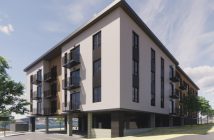(Photo above: Exterior before/after Redmond Municipal Airport parking lot lighting improvements | Photo Courtesy of Ameresco)
City-wide initiative features upgrades in multiple municipal buildings
Sustainability experts are poised to tally public savings flowing from a broad-ranging $1.2 million initiative triggered by the City of Redmond to enhance energy efficiencies and reduce costs across a slate of public facilities, including major lighting upgrades at the Roberts Field regional airport.
City leaders have long touted improved performance goals — especially in the context of responsible use of taxpayer funds – and in the past energy projects have targeted street lights and large usage equipment within the water and wastewater utility.
But in 2014 the municipality signaled a ramping up on the green front and an ongoing commitment to the pursuit of energy conservation and lowering operating costs by partnering with energy savings specialist Ameresco on a comprehensive Energy Savings Performance Contract (EPSC) in a bid to reduce energy costs and modernize energy infrastructure.
Oregon Department of Energy (ODOE) defines an ESPC as a public contract be-tween a state agency and a qualified energy service company “for the identification, evaluation, recommendation, design and construction of energy conservation measures, including a design-build contract, that guarantee energy savings and performance.”
Agencies that opt to use this route can pick a specialist firm, via a Request for Proposal (RFP) process, from a list of ESCO’s pre-qualified by the ODOE that follow efficient design guidelines to replace and update aging infrastructure in a “budget-neutral” approach — i.e. without additional capital costs — to help improve building performance, lower energy costs and reduce the carbon footprint.
After being selected and before the agreement was formally inked, Ameresco conducted an energy audit on more than 272,000 square feet of city-owned building space, spanning six locations and ten buildings, and identified energy conservation measures that the company could design, construct, commission and verify.
City of Redmond Public Works Director Bill Duerden said a number of projects were put forward following this “technical energy audit” with the council then selecting which to pursue based on a number of criteria, including economic feasibility and time to payback.
Once the project punch list was agreed, councilors gave the green light to enter into the energy savings contract and moved forward on a phased program including a project development plan, followed by construction of the improvements.
As part of a guarantee to deliver on anticipated savings for the upgrades, which finished completion last year, the company then measures and verifies performance by comparing to an energy baseline calculated prior to the installation of energy efficiency measures. Measurement and verification of the improved performance and resultant savings is expected to be undertaken this summer.
Projects completed in Redmond included comprehensive lighting upgrades, controls enhancements and the installation of solar photovoltaic systems at Redmond Airport designed to enhance comfort levels for passengers and building occupants and to improve the light quality at the facilities.
Other buildings included in the initiative were the Air Rescue & Fire Fighting Building and Snow Removal Buildings at Roberts Field, the Public Works Complex, Waste Water Treatment Plant and Juniper Golf Course.
Improvements made across the multiple City facilities geared toward a reduction in utility bills covered expansion of existing HVAC controls to provide energy savings and decreased maintenance, and afford staff the ability to troubleshoot heating and cooling issues, remotely. Upgrading lighting to LED also provided for reduced energy use, decreased maintenance costs and uniform full-spectrum light.
In all, the City is expected to realize around $100,000 annually in energy savings from the completed projects — with the associated environmental benefits including the reduction of more than 1.2 million pounds of CO2 output, equivalent to planting 22,672 trees or eliminating 186 cars from the road annually.
In addition, with the aid of Ameresco, the City leveraged the energy savings of the projects to secure around $250,000 in utility incentives from the Energy Trust of Oregon and the Oregon Department of Energy.
Ameresco Portland-based Business Development Manager Joe O’Donnell said, “We identified nearly $1.2 million in energy system improvements across the City of Redmond. A turn-key project was delivered, including: audit, financing support, design, construction management, commissioning, training and measurement and verification.
“This comprehensive program was delivered to the City as a budget neutral solution, and will result in positive cash flow in the first year.
“Improvements were made at facilities across the City, including Roberts Field (Airport), police station, public works, public golf course, wastewater treatment plant and city-wide IT services. Upgrades included HVAC controls and interior and exterior lighting. Solar PV arrays were installed on two airport building rooftops, with a combined production capacity of twenty kW.
“LED lighting installed at the Airport, and select locations across the City, will use half the energy of traditional lighting, and is expected to last up to twenty years without maintenance. The smart controls at the Airport sense occupancy, and reduce lighting and heating energy when indoor areas are vacant.
“Cost savings on the original project scope allowed for additional lighting to be installed in the airport terminal, within the original budget. These upgrades are guaranteed to produce over $90,000 in annual savings. As the project progressed, Ameresco managed to secure additional incentives with the City expected to receive an increase from the original incentive estimate.”
Duerden added, “This project reflects the City of Redmond’s ongoing commitment toward the pursuit of energy conservation and lowering operating costs.
“Utilizing this public/private financing model leads to a triple bottom line. It has helped us to replace our aging infrastructure with innovative design and construction without incurring additional capital costs. It’s a win-win-win for the City, our residents and the environment.”
O’Donnell said Ameresco has a long history of partnering with counties, schools, municipalities and commercial entities to improve energy infrastructure and install renewable energy technologies, adding, “The ESPC financing model has made the solution an increasingly popular option for customers across North America, enabling budget-neutral energy efficiency upgrades by guaranteeing a minimum level of energy savings over the term of the contract.
“Ameresco coordinates the upfront project costs and the City repays that investment with their energy savings over time.”
Duerden observed, “Our partnership with Ameresco enabled the completion of improvement projects that we otherwise did not have the staff to pursue.
“They provided professional and technical expertise every step of the way to include project design and management as well as finance support and incentive funding administration.
“I think it was a relatively unique take on the ESPC approach as we hit a group of facilities under the city umbrella rather than just focusing on one building, and utilized the ODOE-issued template contract as a basis for discussions.
“This fits in with our philosophy of wanting to be as efficient as we can with public facilities and we were able to improve energy efficiency and reduce energy costs as well as maintenance costs.
“Over the long term the model will see savings see each year that will pay the financing debt service and the project as a whole should pay for itself after ten years.”
Under a separate contract, Redmond Area Park and Recreation District (RAPRD) partnered with the City of Redmond and Ameresco on a $350,000 energy savings project that took advantage of favorable incentives from the Energy Trust of Oregon.
The Cascade Swim Center now benefits from several major facility improvements, including new equipment and automated facility systems controls. Existing equipment underwent extensive renovation and retrofitting to extend its life, improve functionality and cut down on utility costs.
Ameresco
Founded in 2000, with its corporate headquarters in Framingham, Massachuttes, Ameresco, Inc. (NYSE: AMRC) is an independent provider of comprehensive services, energy efficiency, infrastructure upgrades asset sustainability and renewable energy solutions for businesses and organizations throughout North America and Europe. www.ameresco.com.





